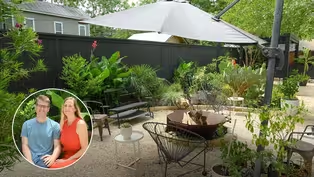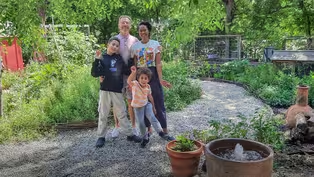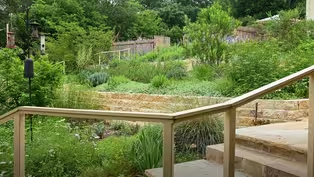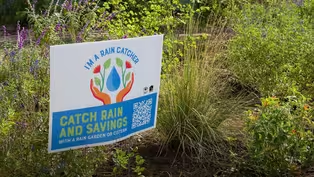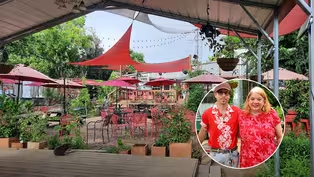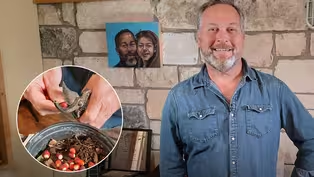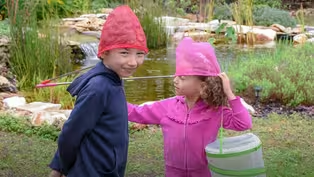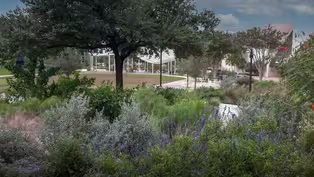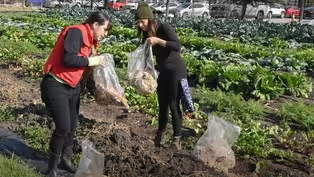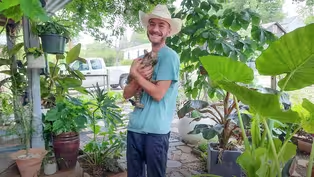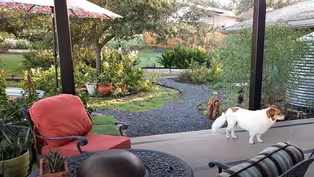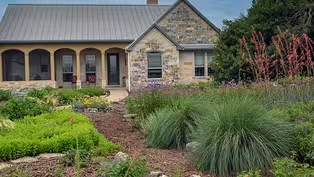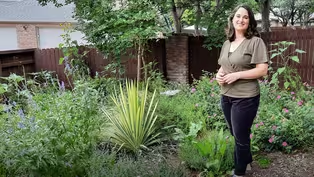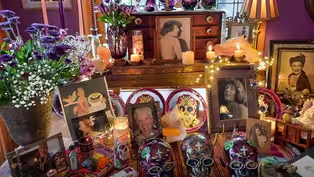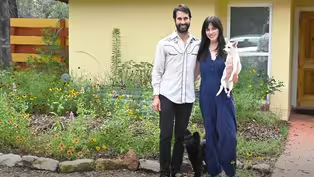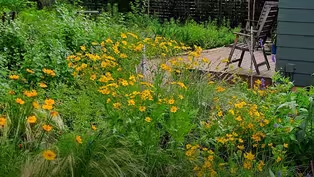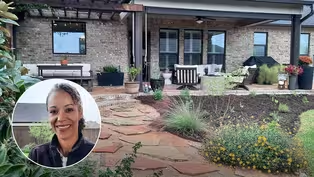
Three Stories of Change: Wildflower Pocket Gardens
Clip: Season 29 | 9m 23sVideo has Closed Captions
Pollinators and birds waltz around native plants where lawn grass once dominated.
Butterflies, bees, birds, and hummingbirds waltz around wildflowers, native clump grasses and perennials in front yards and backyard family hangouts where lawn grass once dominated. In different timelines, spaces, and designs, Studio Balcones landscape architects Jennifer Orr, Ilse Frank, and Michael Meihaus explain lawn removal techniques and how they integrate vegetable gardens and patios.
Problems playing video? | Closed Captioning Feedback
Problems playing video? | Closed Captioning Feedback
Central Texas Gardener is a local public television program presented by Austin PBS
Support for CTG is provided by: Lisa & Desi Rhoden, and Diane Land & Steve Adler. Central Texas Gardener is produced by Austin PBS, KLRU-TV and distributed by NETA.

Three Stories of Change: Wildflower Pocket Gardens
Clip: Season 29 | 9m 23sVideo has Closed Captions
Butterflies, bees, birds, and hummingbirds waltz around wildflowers, native clump grasses and perennials in front yards and backyard family hangouts where lawn grass once dominated. In different timelines, spaces, and designs, Studio Balcones landscape architects Jennifer Orr, Ilse Frank, and Michael Meihaus explain lawn removal techniques and how they integrate vegetable gardens and patios.
Problems playing video? | Closed Captioning Feedback
How to Watch Central Texas Gardener
Central Texas Gardener is available to stream on pbs.org and the free PBS App, available on iPhone, Apple TV, Android TV, Android smartphones, Amazon Fire TV, Amazon Fire Tablet, Roku, Samsung Smart TV, and Vizio.
Providing Support for PBS.org
Learn Moreabout PBS online sponsorship- We learned very quickly that we do not like mowing at all.
So we started killing our lawn in August of 2022.
And we had black plastic down for quite a long time.
And finally, in May of 2023, we lifted up the black plastic and seeded it.
I'm Ilse Frank, and I am a native Austinite and a landscape architect with Studio Balcones.
My husband, Tim Braun, and I purchased this home in November 2021, and we had been living in condos previously, and this is our first yard as adults since leaving our parents' nests.
And so it was a bit of an adventure to begin on.
I've always been interested in native plants and wildflowers and seeding.
And so, it was just an opportunity to experiment, honestly.
Like, I've never had a yard.
I was very nervous, honestly.
Like, is this is going to work?
Like, what's going to happen here?
- My name is Jennifer Orr, and we bought this house fall of 2008.
And when we bought it, there was a fence around it.
There was a big red oak in the front yard that we've since lost.
And really horrible nandinas, and other invasive shrubs and that's about it.
And lawn.
Yeah.
- Pretty boring.
We had to get rid of the grass the hard way with a shovel, with pickaxes and just get after it.
And you dig it all by hand.
And thankfully, I think we were, you know, still in our 30s.
So our bodies can handle it for a day.
But, yeah.
And then we just had to keep after it and keep weeding until I think, finally over the last 15 years or so, the garden has established dominance and so we've been able to weed less.
Jennifer thankfully has a design eye, very artistic and instead of just doing what I would have done is just rectangles or square, she designed a very contoured landscape here.
So the backyard was a driveway where all the flowers are now.
- A driveway and a big, concrete just patio or, I mean, the middle of it was basically just a- - Right it was a concrete pad.
And so as a result, and Jennifer can speak more intelligently to this, that soil underneath the concrete had never had seeds in it, or at least not since maybe the '30s or the '20s.
And so when we seeded it, there was no competition for those seeds 'cause there was no weed base.
- There was no St. Augustine or Bermuda or dandelions or anything, or Johnson's grass or I mean, so many things that can get in the way.
And believe it or not, all of our native wildflowers and even grass mixes, they like crappy, poor soil.
They respond well to that kind of soil.
I was curious to try seeding.
My employee, well, he was my employee, now he's my business partner, Michael, had done that to his entire front yard, had just killed all the grass and gone with native seed.
It seemed like it was something that a lot of people were doing.
And so I was like, well, let's try; this is a perfect place to try it.
- My name is Michael Meihaus.
I'm a principal at Studio Balcones Landscape Architects.
This is my native Texas landscape.
This is a yard that we've been managing since 2018.
So going on about 6 or 7 years now.
What used to be Bermuda grass is now our experiment.
Our main goal was to get rid of Bermuda grass.
So, the first step was, okay, how do we how do we create a good environment for seed germination?
We wanted to just do mostly herbaceous cover from seed at first.
And, I don't like to do one treatment over the whole area since it's, you know, it's an experiment.
We can try different things.
So I tilled half the yard and raked out what we could of the Bermuda roots.
And the other half we just, we just let go essentially, and seeded over the Bermuda grass.
And we did it in fall of probably 2018.
So this yard was seeded once, six years ago.
And it's probably due for another round, but our prep was only native soil and a little bit of compost as a top dress, just to kind of get some nutrients back in there.
- I'm pretty sure that this was farmed land before it was developed in the '50s, our neighborhood here.
And so it's pretty good soil, as far as I can tell.
But we did amend it with some compost.
And we used two different seed mixes.
Mostly we are just seeing the wildflowers and little bits and pops of grasses have been coming up.
- [Jennifer] You know, the agaves, the grasses, they can kind of hold the garden when everything else is really tired and thirsty.
- With so many great, like, really just kind of workhorse plants, you know, that are widely available to put in your landscape, lindheimer muhly really being one of the best for sure.
It does create structure.
In our yard, we used it to just designate, you know, the wildflower area from something else.
These have been in the ground for almost seven years now, and I've never cut them back.
They don't have a problem pushing through the old growth.
I would encourage people to resist the temptation to cut back bunch grass if they can.
Really I've been experimenting with just letting things go, no disturbance.
This is a way to see what happens if we just let it let it go.
So all that dead herbaceous cover, everything that's senesced and gone to seed is just matted down over time.
And we walk on it a little bit, you know, occasionally pull weeds, but for the most part, not cutting back grasses, largely not cutting back any of the herbaceous growth.
- Controlling an environment can be done with less effort.
- [Jennifer] That's true.
- Because you accept new things coming in and really, you're just there to kind of provide parameters to make sure nothing dies.
- It's like parenting.
- Yeah.
Right.
We're the guardrails of the garden.
- Right, right, right, right.
You don't want anything horrible to happen but it's not like you can control it all.
- This little strip is our 2024 project.
We put in the raised beds, which will keep the Bermuda out, we hope, from the vegetables and we put in ollas also with the raised beds.
So, we collect our HVAC condensate.
And so my hope is just to take the watering can, fill it up over in our cistern and then fill the ollas and then we'll have a little seating area, too, so we can enjoy the prairie.
- Our little garden we built this year for my two-year-old is really just about just, creating a little bit of a barrier to introduce some new soil and create a good environment for some vegetables and flowers.
We like rocks.
So you know, collecting rocks, stacking rocks, piling them, critters like them, too.
Really, the rock work is a great way to slow water down and to create these little just like little micro catchments where plants can take roots and seed can distribute and germinate.
- We put in a Little Library.
My husband is a writer, and he's a professor at Saint Edward's.
And it's just such a joy.
Like, everyone stops by and peeks at it, and we like to, like, curate it.
We also have a dog library, which is where you can take a stick or leave a stick and, yeah, it's just like a fun little piece of, like community and getting to know our neighbors.
- Like, I feel like people should know, should have some relationship to the trees and plants that keep us alive.
I do want my kids to have a relationship with nature and I think your yard is the easiest place to do it.
I mean, going to national parks and state parks, that's great too, of course, but.
- Yes.
- This is the day to day.
- But we can't live in one.
- No, we can't live in one.
But.
Yeah, but we can bring butterflies to this one.
- Just like never-ending butterflies and bees.
It's amazing.
It's just like a constant show.
Our dog and our cat are just, like, enamored.
So they just, like, sit on our couch looking out the front window at the yard and we love it.
And everyone stops to look.
It's just this is the gift that keeps on giving.
- I know this has been sort of beat to death, but getting away from lawn and planting native plants does create habitat.
And- - Yeah, it does.
- And that's good for everybody, not just the animals.
But it's good for the humans because, you know, we're all connected and it can create a, just a more interesting environment, I think, throughout the year.
- We're plant enthusiasts, obviously.
we're here to learn about the landscape and this is our little microcosm to do that, so.
We like to have fun and watch things grow and watch it change year after year.
(warm gentle music)
Contemporary Courtyard Makeover
Video has Closed Captions
Clip: S29 | 9m 29s | In a ground-level makeover, a young couple went for outdoor living and wildlife habitat. (9m 29s)
Blank Yard to Wonder-Filled Gardens
Video has Closed Captions
Clip: S29 | 8m 54s | Richie and Nkiru Gelles applied muscle and imagination to turn their backyard into a lively habitat. (8m 54s)
Garden Design: Plant Communities for Wildlife
Video has Closed Captions
Clip: S29 | 9m 27s | On an old lot, new owners envisioned an urban wildlife sanctuary for year-round beauty. (9m 27s)
Rain Gardens: Catch and Hold Runoff Water
Video has Closed Captions
Clip: S29 | 7m 55s | See how to create a rain garden with beautiful native and adapted plants for pollinators. (7m 55s)
Butterfly Garden Performs at Repertory Theater
Video has Closed Captions
Clip: S29 | 9m 14s | An urban butterfly sanctuary restores life to soil and soul in daily pollinator performances. (9m 14s)
Easy Way to Germinate Texas Mountain Laurel Seeds
Video has Closed Captions
Clip: S29 | 3m 40s | Get the secret to success with Billy Garza. (3m 40s)
Music to Your Ears: Food, Fun, Family
Video has Closed Captions
Clip: S29 | 7m 37s | Musicians and home-schoolers Lisa and Shane Lamb grow their garden goals one weekend at a time. (7m 37s)
Parking Lot to Wildlife Habitat Park: St. John Encampment
Video has Closed Captions
Clip: S29 | 8m 22s | Once crowded with cars, this former mall parking lot now gathers another kind of community (8m 22s)
Grow Soil Health with Mushroom Blocks
Video has Closed Captions
Clip: S29 | 4m 35s | Smash and mulch recycled mushroom blocks for healthy, productive plants. (4m 35s)
Garden Love Germinates at Rental House
Video has Closed Captions
Clip: S29 | 7m 44s | Cyrano Carroll wasn’t keen on digging in until a chance opportunity changed his life. (7m 44s)
Video has Closed Captions
Clip: S29 | 9m 17s | Kat and Dave Sherby fell for a big yard that beckoned creative brainstorming for wildlife watching. (9m 17s)
From Cattle Ranch to Wildlife Paradise
Video has Closed Captions
Clip: S29 | 8m 42s | These days, wildlife graze four acres of native plant gardens on former ranchland in Jarrell. (8m 42s)
Drought-tough Cottage Design with Native Plants
Video has Closed Captions
Clip: S29 | 8m 11s | Alexa Volpe never knew that gardening could be so hard until moving to rocky soil in San Antonio. (8m 11s)
How Biking Led to No Lawn Native Plants
Video has Closed Captions
Clip: S29 | 8m 43s | Biking along country roads inspired Laura O’Toole to rip out lawn for beautiful native plants. (8m 43s)
Celebrating Life on Day of the Dead
Video has Closed Captions
Clip: S29 | 8m 11s | Dia de Los Muertos pays tribute to our lost loved ones who influenced our lives, souls, and culture. (8m 11s)
Small Yard Makeover: From Grass to Wildlife Diversity
Video has Closed Captions
Clip: S29 | 9m 30s | Ecologist and mycologist Chris Garza controlled flooding rain and restored the soil in a small yard. (9m 30s)
Three Stories of Change: Wildflower Pocket Gardens
Video has Closed Captions
Clip: S29 | 9m 23s | Pollinators and birds waltz around native plants where lawn grass once dominated. (9m 23s)
Less Lawn, More Wildlife, Lessons Learned
Video has Closed Captions
Clip: S29 | 9m 23s | Natalie McAnarney’s family spends more time in the backyard since she swapped dull for enchanting. (9m 23s)
Providing Support for PBS.org
Learn Moreabout PBS online sponsorship

- Home and How To

Hit the road in a classic car for a tour through Great Britain with two antiques experts.












Support for PBS provided by:
Central Texas Gardener is a local public television program presented by Austin PBS
Support for CTG is provided by: Lisa & Desi Rhoden, and Diane Land & Steve Adler. Central Texas Gardener is produced by Austin PBS, KLRU-TV and distributed by NETA.
